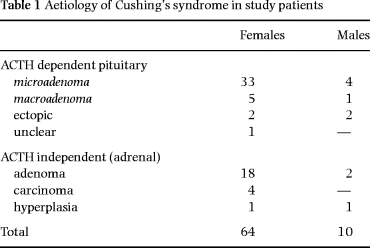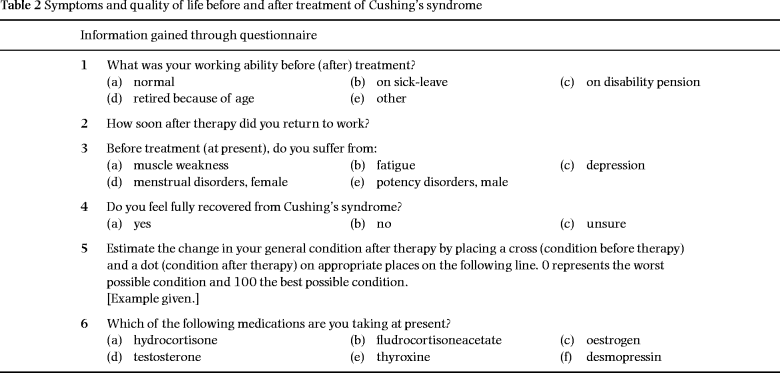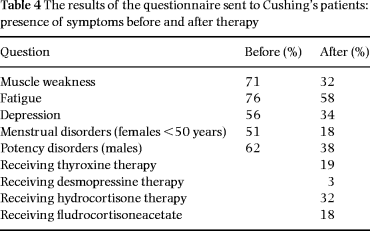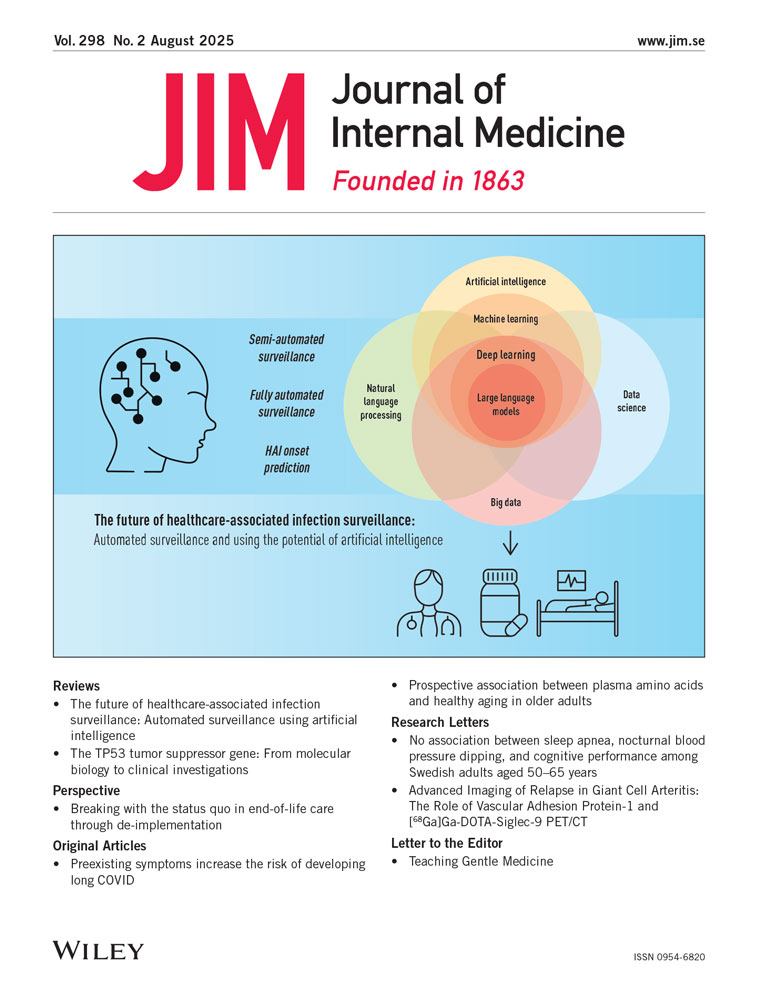The survival and well-being of patients treated for Cushing’s syndrome
Abstract
Abstract. Pikkarainen L, Sane T, Reunanen A (Helsinki University Hospital and National Public Health Institute, Helsinki, Finland). The survival and well-being of patients treated for Cushing’s syndrome. J. Intern Med 1999; 245: 463–468.
Objective. The main aim of the study was to evaluate the survival, well-being and working capacity of patients treated for Cushing’s syndrome.
Design. The study was carried out by retrospectively analysing patient records from years 1981–94. Follow-up time was extended from the time of diagnosis to the end of 1996. A questionnaire dealing with symptoms prior to and after therapy, and the quality of life estimated on a Visual Analogue Scale (VAS) was sent to all surviving patients.
Setting. The study was performed in a university hospital.
Main outcome measures. Survival, subjective well-being, working capacity before and after treatment and disappearance of symptoms after treatment of Cushing’s syndrome.
Results. During the follow-up time 10 patients died out of a total of 74. The overall standardized mortality ratio (SMR) was 168% (95% CI 81–309%). The SMR of patients with pituitary disease was 267% (89–525%), and in patients with adrenal adenoma it was 135% (16–489%). Forty-six per cent of the surviving patients stated that they felt fully recovered from the disease, but the proportion of patients having persisting symptoms after treatment was also noteworthy. The mean VAS score (range 0–100) was 19 (SD 14) before treatment and 82 (SD 18) after treatment (P < 0.001). After treatment, 81% of the patients were able to return to work, 11% retired because of disability, 5% retired because of age and 3% were on sick-leave at the time of answering the questionnaire. During the follow-up time, 42% of the patients with pituitary disease suffered a relapse. However, the effect of the relapse on well-being was not significant.
Conclusions. The mortality risk of patients treated for Cushing’s disease was not significantly increased compared with that of the general population. Many symptoms persisted even years after therapy. After clinical recovery, working ability was not always regained.
Introduction
The results of previous studies have shown that untreated Cushing’s syndrome is a fatal state, mostly as a result of cardiovascular complications [1–3]. According to Ross & Linch [4], in 1981 the mortality rate of treated Cushing’s syndrome patients was still found to be four times greater than average. No recent data on the prognosis of Cushing’s syndrome have been published. Published data on the well-being and working capacity of treated patients are also scarce.
The most important symptoms causing functional disability in patients with Cushing’s syndrome are the complications of osteoporosis, impaired muscle strength, and depression and other psychiatric symptoms.
It is well known that after successful treatment, clinical recovery is far slower than the biochemical recovery from hypercortisolism. There is an improvement in bone mineral density in treated Cushing’s syndrome patients [5], but the osteoporotic changes take 1–2 years to normalize [2]. The lost ability to function in everyday life is regained slowly over 6–30 months, according to the results of previous studies [6], and the slow rate of recovery may be disappointing to the patient [7]. Late relapses of hypercortisolism after pituitary surgery may also impair recovery.
In this study we addressed the long-term outcome of patients treated for Cushing’s syndrome by analysing the effect of the disorder on survival, well-being and working capacity, and the disappearance of symptoms after treatment of the syndrome.
Methods
Study population
The study population consisted of all 74 consecutive patients (64 females, 10 males) treated at the Department of Medicine of Helsinki University Hospital because of verified Cushing’s syndrome from 1981 to 1994. The aetiology of Cushing’s syndrome is shown in Table 1. Diagnosis was based on typical clinical presentation, laboratory findings, radiological imaging and histological findings, and the outcome of operative treatment. All adrenal adenomas were operated upon via laparotomy. Pituitary adenomas were operated upon by selective transsphenoidal adenomectomy. After their primary treatment, 25 patients were considered to be in remission. Sixteen patients had additional pituitary irradiation. The age range of the patients was 23–79 years and the mean age was 44.6 (SD 14.5) years.
Study methods
Patient records from 1981 to 1994 were analysed retrospectively. The follow-up time was extended from the time of diagnosis to the end of 1996. Copies of death certificates of all patients deceased during follow-up were obtained from Statistics Finland.
A retrospective questionnaire dealing with symptoms and quality of life before and after treatment estimated on a Visual Analogue Scale (VAS) (range 0–100) was mailed to all surviving patients during autumn 1995. Questions dealing with symptoms and working ability at the time are presented in Table 2. Questions dealing with the situation prior to treatment were similar.
Successful treatment was defined as that resulting in normalized urinary cortisol, disappearance of symptoms, and absence of relapses.
Statistical methods
The data collected were processed by using the BMDP statistical software. Differences between groups were calculated by using Student’s t-test when appropriate. Correlation was calculated by using Pearson’s correlation analysis. Life tables for the expected mortality of the whole population for 1986–90 were obtained from Statistics Finland. The standard mortality ratio (SMR) was calculated as 100 × the number of observed deaths (O) per number of expected deaths (E). The number of expected deaths was calculated by Σ[probability of death per 1000 by age and sex × follow-up years]. The 95% confidence interval (CI) was derived from OL/E – OU/E. O was regarded as a Poisson variable and its related confidence interval was derived from tables. The follow-up time, extending from the time of diagnosis of Cushing’s syndrome at the Department of Medicine, to the end of 1996, or death, ranged from 0 to 15 years with a mean of 7.4 years.
Results
Mortality
During the follow-up period, 10 patients out of the total of 74 died. The causes of death are shown in Table 3. The overall SMR of Cushing’s patients compared with that of the general population was 168 (95% confidence interval 81–309, NS). To exclude the effect of malignant diseases on mortality, cases of adrenal carcinoma and ectopic Cushing’s syndrome were omitted from further mortality calculations. Two of the four patients with adrenal carcinoma died during the follow-up time. Two were alive and in full remission at the end of follow-up. The SMR of patients with benign pituitary or adrenal disease was 202 (95% CI 87–396, NS). In subgroup analysis, patients with pituitary adenoma had an SMR of 267 (95% CI 89–525, NS) and patients with adrenal adenoma, 135 (95% CI 16–489, NS).
Disappearance of symptoms of Cushing’s syndrome
Of 65 surviving patients, 62 (95%) returned the questionnaire. One patient died after returning the questionnaire. Answers to the questions are shown in Table 4. Forty-six per cent of the patients stated that they felt fully recovered. Thirty-one per cent did not feel recovered and 23% chose the alternative ‘unsure’. The mean Visual Analogue Score for the general condition was 19 (SD 14) before treatment and 82 (SD 18) after treatment (P < 0.001). The presence of depression as defined by the patients’ subjective estimation after treatment correlated with depression before treatment (r = 0.35, P = 0.005) and with a low VAS score after treatment (r = – 0.44, P = 0.002). Sex and age did not correlate with the presence of depression. The proportion of patients who reported hypertension and/or reported receiving antihypertensive medication was 37%. Data on bodyweight at the time of therapy and in 1996 could be obtained from 29 patients. In these patients, weight loss was only moderate (mean weight loss 1.7 kg, median 2 kg, SD 7.5 kg). Three patients who underwent surgery because of adrenal adenoma remained on hydrocortisone substitution therapy.
Working ability
Fifty-six (90%) of the 62 patients answering the questionnaire were of working age (16–64 years) at the time of diagnosis of Cushing’s syndrome. Prior to therapy, 37 (66%) were working, 15 (27%) were on sick-leave and four (7%) received disability pension. The mean duration of sick-leave after therapy of Cushing’s syndrome was 3.8 (SD 4.2) months. After treatment, 30 (81%) of the patients working prior to therapy were able to return to work, two (5%) of them retired because of age, four retired (11%) because of disability and one patient was on sick-leave at the time of answering the questionnaire. Of the patients on sick-leave prior to therapy, seven (47%) were able to return to work, five (33%) retired because of disability, two (13%) retired because of age and one patient was on sick-leave at the time of completing the questionnaire. Three of the four patients who retired because of disability remained on disability pension and one of them is now retired because of age.
The patients who retired because of disability were older than those who returned to work (54 years versus 42 years). They also tended to have additional disabling features such as impaired vision resulting from glaucoma, hearing loss, diabetes, rheumatoid arthritis and, in the case of two patients, cerebral infarction.
Relapses in patients with pituitary disease
During the follow-up time, 15 (42%) of the patients treated by pituitary surgery had a relapse of the disease. Thirteen underwent re-operation and six of these patients received additional pituitary irradiation. Two patients with relapsing disease were treated with pituitary irradiation alone. Patients with relapse of the disease had a somewhat lower VAS score after treatment (71 vs. 84 in the nonrelapse group), but the difference was not significant. Nor was the occurrence of persisting symptoms significantly higher in the patient group with relapse of the disease. To our knowledge, two patients had a relapse of the disease at the time of answering the questionnaire.
Discussion
The mortality risk amongst patients with treated Cushing’s syndrome has been regarded as being significantly higher than average [4]. The data, however, on which this assumption was based are old and the long-term outcome of Cushing’s patients might have improved with prompt diagnosis and better control of the disease, as well as control of the cardiovascular complications linked to it. The standardized mortality ratio in our patients was 168 and that of the patients with pituitary or benign adrenal aetiology, 202. Because of the small numbers of patients and wide confidence intervals, the SMRs, however, were not significantly different from the general population. The small number of deceased patients did not allow detailed comparison of causes of death between Cushing’s patients and the general population. However, it is important to note that the proportion of patients dying from cardiovascular diseases (six out of 10) was not different from that expected in the Finnish population as a whole.
The effects of Cushing’s syndrome on a patient’s mental state vary from cognitive disturbances to severe depression or psychosis. The problems most commonly described by patients in a study published by Gotch [7] were mood swings, violent outbursts and crying spells. Loss of emotional stability causes conflicts in family and social life. Changes in physical appearance, including weight gain, moon face, hirsutism, thin and easily bruising skin with striae cause feelings of self-hatred and social embarrassment [7]. In our survey, 56% of the patients reported depression prior to therapy for Cushing’s syndrome. Interestingly, 34% of the recovered patients reported depression at the time of completing the questionnaire. The presence of persisting depression correlated with a low VAS score after treatment and presence of depression prior to treatment, but it did not correlate with age or sex. When interpreting these results, the obvious inaccuracy of the study method must be kept in mind.
It is well known that after successful treatment, clinical recovery is slower than the biochemical recovery from hypercortisolism. In some patients osteoporotic fractures, fatigue, weakness and persisting mental problems have led to permanent disability. The proportion of patients with Cushing’s disease treated by adrenalectomy and unable to return to work, in a study by Grabner et al. [6], was 24%. In our series, less than half of the treated Cushing’s patients stated that they felt fully recovered from the disease. Over half of the patients complained of persisting fatigue even after successful treatment. Muscle weakness was reported by 32% of the patients. Nineteen per cent of the patients remained unable to return to work and subsequently retired because of disability. Sixty-one per cent returned to work.
The long-term results of the treatment of pituitary Cushing’s disease can be addressed by investigating survival, occurrence of relapses, the need for cortisol replacement therapy, disappearance of symptoms and improvement in work and social performance. The occurrence of relapses varies depending on the treatment method. Relapses occur in about 4–25% of cases after pituitary adenomectomy [8–10]. States resulting from pituitary insufficiency such as diabetes insipidus, hypothyroidism, hypogonadism and lack of growth hormone, which may present as impaired general condition, fatigue and depression [11–13] are relatively common. Lack of growth hormone may play a role in the persisting fatigue in some of our patients who underwent pituitary surgery and the subject needs further investigation. The rates of postoperative thyroid and gonadal insufficiency in patients with Cushing’s disease treated by pituitary surgery in Lindholm’s study [14] were 36 and 49%, respectively. In our study material, seven of the 37 patients with pituitary disease treated by means of transsphenoidal surgery were receiving thyroxine replacement therapy. About one-fifth of the women aged under 50 years reported persisting menstrual disorders after therapy of Cushing’s syndrome. Thirty-eight per cent of male patients had potency disorders after therapy. One patient, who had undergone pituitary surgery, had persistent diabetes insipidus.
In conclusion, in our retrospective study of 74 Cushing’s syndrome patients treated between 1981 and 1994, the mortality risk was moderately but not significantly increased compared with that of the general population. Better survival than expected may be a result of improved treatment methods and better control of cardiovascular complications associated with Cushing’s syndrome, such as hypertension. Many of the symptoms experienced by the patients persist even years after therapy. Likewise, working ability is not always regained after clinical recovery. The results emphasize the fact that Cushing’s patients need long-term health and social surveillance, even after biochemically successful therapy.
References
Received 1 December 1997; accepted 22 September 1998.








